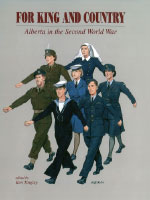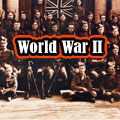The Calgary Highlanders at the Walcheren Causeway: October, 1944
David J. Bercuson
Reprinted with permission of the author and publisher of For King and Country: Alberta in the Second World War The B Company advance was led by 12 Platoon, commanded by Lt. Walter Lefroy. John Morrison was with them, and later recalled: "We headed out and everybody was with us and out in the middle of the causeway was this enormous big crater.... When we got to the crater they put in a big barrage of mortar fire. Everybody hit the deck.... When it eased up somebody said 'lets go' and away we went.... We got down on the south side and crept along there. Most of the fire was going over the top, but there was lots of it.... Eventually we got up to a big tank trap.... There were pieces of railroad track that had been cut off at a sharp angle placed in this concrete.... Before that, this French fellow behind me had been killed by a rifle grenade. I actually saw it out of the corner of my eye. We went on and we could hear the Germans on the other side of the tank trap. We thought 'well, we can't take them on'. I had been hit with some schrapnel, [Corporal D.H.] Richardson had been shot through the arm, and then Lefroy got it through the chest."19 Chewed up, 12 Platoon could go no farther.
The B Company advance was led by 12 Platoon, commanded by Lt. Walter Lefroy. John Morrison was with them, and later recalled: "We headed out and everybody was with us and out in the middle of the causeway was this enormous big crater.... When we got to the crater they put in a big barrage of mortar fire. Everybody hit the deck.... When it eased up somebody said 'lets go' and away we went.... We got down on the south side and crept along there. Most of the fire was going over the top, but there was lots of it.... Eventually we got up to a big tank trap.... There were pieces of railroad track that had been cut off at a sharp angle placed in this concrete.... Before that, this French fellow behind me had been killed by a rifle grenade. I actually saw it out of the corner of my eye. We went on and we could hear the Germans on the other side of the tank trap. We thought 'well, we can't take them on'. I had been hit with some schrapnel, [Corporal D.H.] Richardson had been shot through the arm, and then Lefroy got it through the chest."19 Chewed up, 12 Platoon could go no farther.
Back on the causeway, Clarke and Holm took refuge in the crater. The shellfire was intense. Holm later remembered: "The heavy shells were the worst. The explosion would send a shock through you that would reach the very depths of your nervous system and put in doubt your ability to take it.... I swore that if I ever got out of this hellish place alive I wouldn't mind eating dirt for the rest of my life."20 John Martin was in a somewhat more exposed position: "This shell or something came and 1 could just see stars, all colours of the rainbow. And some guy yelled 'I'm hit'. I said 'where are you hit?' He says 'I think in the back.' You could tell that he wasn't real bad. I was at the stage where I thought I would give anything to get out of there. I said 'you lucky son of a bitch."21 The Germans also fired the 88mm at the end of the causeway, skipping shells down the roadway. The sound terrified the advancing infantrymen. The position of B Company was untenable. Clarke reported that he was unable to make progress and requested permission to withdraw. Ellis obtained Megill's sanction22 and as B Company pulled back, they took the remaining men from the Black Watch with them. They were off the causeway by 0300.23 It was clear the Highlanders would have to try something else and Clarke and Ellis went back to Brigade HQ to confer with Megill on what that might be.
The answer the three commanders came up with was yet another assault, but with a different fire plan. This time two field artillery regiments would concentrate their fire on a frontage of some 750 metres with a creeping barrage that would lift 50 or so metres every two minutes. Advancing behind this barrage, Major Bruce McKenzie's D Company started back at 0605 on the morning of 1 November. German shelling was still heavy but the German machine gun fire had slackened off, probably because of the creeping barrage. However, there appeared to be no let up in small arms and sniper fire as D Company crept around the crater towards the end of the causeway. At 0715 they radioed that they were nearing the German roadblock; at 0715, they were past it. Then, at 0717, they called for more artillery on their front.24 Dawn was now breaking as the company's leading troops inched their way forward; it was broad daylight at 0950 when they radioed that they had reached the end and were beginning to fan out onto the eastern end of Walcheren Island, one platoon moving north, the other south. The first of some 43 prisoners were sent back as McKenzie radioed for the following companies to come forward.25
Clarke's B Company and Major Wynn Lasher's A Company were waiting on the causeway for word to move up. As D Company began to secure the bridgehead, they advanced. A Company crawled forward on the right side of the causeway [facing the Germans] and was supposed to move north once off the causeway. It made good progress at first, but then came under heavy sniper fire and was forced to hold up. B Company, on the left side of the causeway, made it across despite the bad footing and began to advance south along the front of the dyke, toward a cluster of farm buildings about 600 metres south of the D Company positions. Moving single file, they got close enough to assault the buildings, but Clarke needed covering fire to get his men over the dike and his radio was not working; he had no contact with battalion headquarters. He could literally see Ellis's position across the salt marsh but he had no way of communicating with him. Clarke would later remember his "despair and exasperation at our position because we could actually see battalion across the flood plain on the far dyke. We hoped that they would appreciate our position and act. This of course was a ridiculous and foolish hope."26 He sent two runners to call for mortar or artillery cover, but they never reached battalion HQ.
Back at battalion HQ Ellis thought things were falling into place; at 1210 the Maisonneuve received the warning order to be ready to move across the causeway at 1305 to reinforce the Highlanders. But in fact the three forward Highlander companies were taking heavy casualties and A Company was making no progress at all. Lt. Howard O. Schoening accompanied Lasher who went forward to get his company moving: "I had just come up beside a slit trench and was talking to Wynn Lasher and two other people. I got up ... and got hit in the right arm.... The force of the bullet swung me around and I landed beside the slit trench again. I rolled over and went into the trench.... Lasher was hit by the same burst, he was hit in the back.... Eventually I got up and so did Lasher. The firing had stopped. We started back towards where the regimental aid post was and eventually got back."27 With Lasher and Schoening gone, A Company had no commissioned officers left on the causeway. At roughly 1545, Typhoon fighter bombers appeared over the causeway and dove on the German gun positions firing rockets and cannon.28 Then two squadrons of Spitfires flew over to continue the air assault but the German guns were well dug in and the defenders tenacious; Highlanders continued to fall. Clarke was down to less than 25 men.
At l545 Ellis, Captain Gordon Sellar and Brigade Major George Hees (from 5th Brigade HQ) went onto the causeway to see what was happening. Ellis looked neat and calm as he moved from position to position, talking to his men and encouraging them. Sellar would later recall: "We started up the causeway ... and with the first of these shells that came over, I dived into this hole with the two riflemen that were in there and when I looked up [Major] Ellis was standing up top talking to us. I felt rather silly and got out and stood beside him. We did this all the way up the causeway, stopped at every slit trench and talked to everybody and paid no attention to the shelling.29
Notes
19. Reed interview with John Morrison, in the possession of the author.
20. Holm, pp. 36-37.
21. Reed interview with John Martin, in the possession of the author.
22. The war diary is confirmed on this by Clarke to Tennant, 7 April, 1964, in the possession of the Calgary Highlanders Regimental Funds Foundation collection, Museum of the Regiments, Calgary.
23. WD, Black Watch, 1/11/44.
24. CIB message logs, 1/11/44.
25. Ibid., WD, CH, 1/11/44.
26. Frank "Nobby" Clarke to Jeffrey Williams, 26 July, 1987, courtesy of Jeffrey Williams. The letter is in the possession of the Calgary Highlanders Regimental Funds Foundation collection, Museum of the Regiments, Calgary.
27. Reed interview with Howard Schoening, in the possession of the author.
28. CIB Message logs, 1/11/44.
29. Reed interview with G. Sellar, in the possession of the author.








